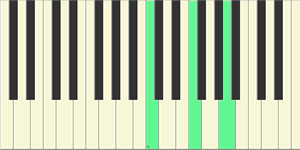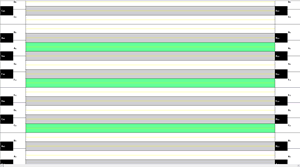Sing & See Research
Sing & See was originally developed as part of a research project at the University of Sydney, in Australia. The aim of this research was to investigate how the use of computer technology could enhance singing training. On this page I have outlined some of the interesting results of this research. Other research publications are also available.
Does real-time visual feedback help in learning to sing in tune?
This was the topic of Pat Wilson's Master of Applied Science research project. To give some answers to the question she devised an experiment that compared different types of real-time visual feedback.
Subjects were recruited from around the university campus for an hour long "singing lesson". During the lesson they received one of two different types of real-time visual feedback, or else none. Two types of visual feedback were investigated - either a piano keyboard display where the key corresponding to the note being sung lit up, or a 'pitch trace" showing how the note being sung changed as the singer sings along (if you use Sing & See you will recognise these two displays) as they're both incorporated into the software.
| Keyboard type of display | Pitch trace type of display |
 |
 |
As in any experimental study of this type, the tricky bit is about how to manage the "control" group of subjects - in other words how do you make sure that the people who don't get any real-time visual feedback aren't disadvantaged simply because they're missing out? Pat solved this problem by giving the control group a "fake" computer display that had some of the same features as Sing & See - you could play notes on the keyboard - it just didn't show what the singer was singing. So they had a computer in their lesson, but no real-time feedback.
Subjects were first tested to get an idea of their existing skill level, and assigned to one of three skill groups. This was done so that appropriate exercises could be used - more difficult exercises were used for the higher skilled groups. They were then tested on that skill exercise, given a lesson incorporating one of the three types of computer interaction, and then tested again on the same pitc exercise.
Results
On average, the subjects who were given real-time visual feedback got more accurate at singing the pitch exercise, compared to the ones who didn't get any feedback, who on average didn't improve after their lesson. Statistically, these differences were significant.

Another interesting result was that in all the groups, singers' accuracy was worse DURING the lesson than either before or after - in other words, while they were watching the computer screen, they made larger pitch errors than when they were tested before or after the lesson.
What does it mean?
The most interesting result of course is that using the visual feedback displays helped the singers to improve their pitch skills even after only a single lesson. The fact that the control group didn't improve is not so surprising given that this was a a single short lesson, and other research studies on training people in different types of exercises have also found that without visual feedback a single training session is not enough to improve people's performance.
This result matches up with many of the informal anecdotes that teachers have told us - students whith whom they had been having difficulty suddenly "seeing the light" and making good progress after using Sing & See and actually "seeing" what their voice was (or wasn't) doing.
The second interesting result was that most people actually got worse when they were looking at the computer. Most likely this is because the singer is concentrating on two things - looking at the screen, and trying to sing the exercise. So even though they were learning (after all, they were better afterwards), the singers found it a difficult task to concentrate on the visual feedback. So, while students are actually using the visual feedback, they need to concentrate on what the visual display is telling them, but you should expect their performance to be slightly worse during that practice. Actually, that is good news - after all, nobody is training to sing in front of a computer. And after practising with Sing & See, the student should probably spend some time "recapping" by singing without the computer.
Another interesting result appeared in the study, when the two types of feedback were compared between the different skill groups. It turned out that the subjects who had more musical experience did better on the keyboard display, while the beginners did better on the grid display. Although this wasn't a strong result, it suggests that as a teacher you need to be flexible in how you use Sing & See.
For more details, you'll have to read the actual research paper. This is available here from the iims website. You can also find a full account in Pat Wilson''s thesis which is available from the University of Sydney.


